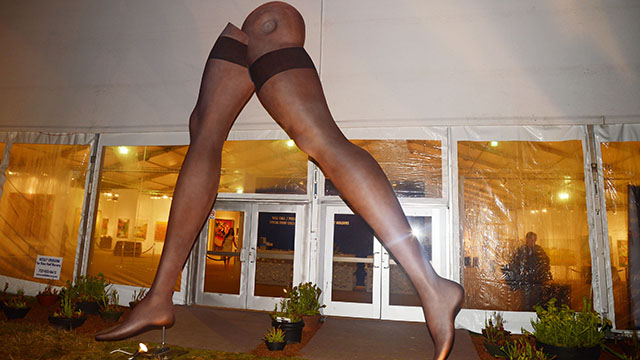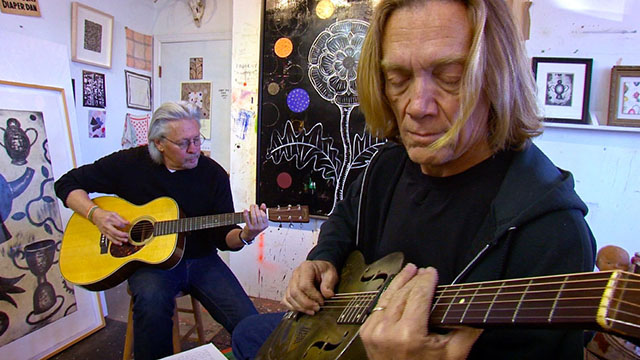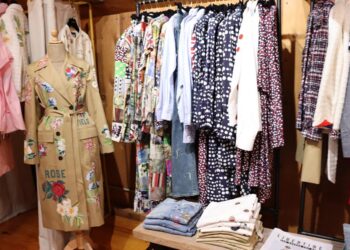What happens when two homeowners install a provocative 16-foot Larry Rivers sculpture on their property that’s located in an idyllic Hamptons village? Directors Beatrice Alda and Jennifer Brooke captured the amusing response in Legs: A Big Issue in a Small Town. The documentary screened at this year’s Hamptons International Film Festival, and we caught up the filmmakers to find out what all the fuss was really about.
How did you learn about Legs (the sculpture)?
BA: We live in the town. We live a few blocks from Legs, and for a long time – a few years – we knew the piece of art, but we didn’t know what the big stink was. How we got to our title, A Big Issue in A Small Town, we just had to figure out what was behind the story.
JB: It’s a huge controversy. What we found out – this is the end of our festival run, so we’ve been to a lot of festivals – people in the Q & As, they all raise their hands and they all talk about in their small town, it’s the same exact thing, except it’s about a traffic light or someone painted a rock or anything – you name it. It’s amazing how every small town has what you see when you first go there and what you realize when you live there, and these little things are the things that bring those things out. The controversies are what bring out what a town really has going on under the surface.
BA: The real fabric of the town.
JB: The underbelly. It deals with issues of race, gender equality.
BA: Xenophobia, homophobia, all these things come out when you scratch the surface on why did that upset you? Or what do you really think of this? Or what really gets me upset is…
JB: That Asian kid that just opened the ice cream shop – that’s in our film. That’s what gets people upset, it all comes out.
BA: Because people, especially in a historic town, are very interested in preservation and keeping things the same. And then of course there’s change that you can’t stop.
JB: Change even means people moving in that were not born there and whose parents weren’t born there. And out here, and in many small towns, that’s very upsetting to locals, but it’s real.
BA: We look a lot about how, in fact there’s even a sociologist in the film who sort of gives a perspective on why it’s important for people to see themselves reflected in their towns. So if you move to this town that you think is quaint and historic and charming and idyllic, you want it to be that. So when somebody puts up something that is provocative, potentially, or disruptive or causing a big stir, it ruffles feathers and makes people think that’s not the town I signed on for. That’s not my small town.
 |
|
Legs at ArtHamptons Art Fair in 2013. (Photo: Patrick McMullan/PatrickMcMullan.com) |
I think in the Hamptons in particular, the change over the past 20 years alone has been rather significant, so people might be apprehensive to it.
JB: And that’s it. So, this film literally deals with how people can’t deal with the rapidity of the change.
BA: I mean is it really about the Legs?
JB: No.
How did you decide who to interview for the film?
JB: Well, the owners of Legs.
BA: If they weren’t going to give us their story, we couldn’t do it.
JB: And then we spread out from there. We went across the street to the woman who complained.
BA: We happened to know pretty much everyone who we interviewed, we know them well, but we just started building concentric circles of who’s in local government, who’s in the arts, who’s been here for generations – all the topics that when you take a town and sort of cut it down center and you see what all the sectors are, we touch on all of that. Everyone who would have an opinion of the town.
Were the owners, Ruth Vered and Janet Lehr, at all reluctant to participate?
BA: No. They wanted to memorialize the art. They wanted to get their word out. They’re very proud of what they’ve done.
JB: They’re public. They took it to the State Supreme Court.
BA: So they feel they’ve earned their right to be outspoken and they want to be heard.
 |
|
Artist Dan Rizzie and musician GE Smith in Legs: A Big Issue in a Small Town. (Courtesy Photo) |
When did you start making the documentary?
BA: Well, we had a funny thing happen to us. We started three years ago.
And what was the funny thing?
BA: We live down the street from it but for those three years we happened to have to move to New York for one of our kids – for the school year. So what became a local, down the street film, became almost a long distance thing. So it elongated our shooting time, but it gave us the perspective to take breaks and go through the seasons.
JB: And the case has been longer than that. The court case ran so long we were able to get to its resolution, as we were finishing the film.
BA: Literally.
JB: We were editing it. We were kinda done and the lawyer called me and said, “Okay, this is in from the Supreme Court.” And we put that on the end.
What’s your perspective on Legs?
JB: We don’t usually give our specific perspective; we let the film do it. Are we people that believe that art should live and let live? Of course we are.
BA: The big point in the film is that it was deemed a structure, therefore it was not legal because of the setbacks, and to me, you can call it a structure, I suppose, but it’s a piece of art.
For more information, visit foreverfilmsinc.com.






